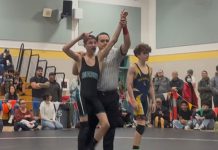Zay recognizes the symptoms now: when my boots and day pack
appear by the front door, his ears go up. His white, brushy tail
flails furiously. He pants, he barks.
Zay recognizes the symptoms now: when my boots and day pack appear by the front door, his ears go up. His white, brushy tail flails furiously. He pants, he barks.
“Quiet!” I demand, crossly. He knows better than to bark. But the excitement is too much: he croons; he sings; small, stifled barks escape his writhing lips. Then Anne and my husband appear with their boots and – o joy! – his leash, and a volley of barks burst forth. He spins in an ecstasy of circles, making it difficult for Anne to snap on his leash. It’s true! O bliss! We’re going for a hike!
He leaps eagerly into the car and scrambles onto his favorite seat, the rear window ledge, where he resembles a car ornament, except that he’s a mite too big, and his head doesn’t bob up and down. Instead he blinks beatifically at the scenery until he recognizes the parking lot at Sprig Lake.
“Stay,” Anne warns him. “Stay … Okay, come,” and he leaps from the car.
We humans, though less demonstrative, enjoy these weekly hikes up Sprig Lake Trail just as much as our dog. Sometimes Anne invites a two-legged friend in addition to Zay. Then kids and dog will lead off, waiting impatiently for us at the trailbends.
The trail winds uphill from Sprig Lake into Mount Madonna County Park, uphill through redwood and tan oak, interspersed with California bay laurel and madrone. One’s footfalls are alternately hushed by the carpet of needles or crackly through the cover of leaves. Ferns and moss and lichen grow in profusion on all sides.
Sometimes we see deer, or hear a squirrel, more often see the blue flash and hear the squawk of Stellar’s jays.
The trail winds up and up and up. I pant. We started these hikes because I have to get in shape for White Stag Phase III hike this summer, and my panting indicates how desperately I need the training.
After our first hike, before Thanksgiving, my husband and I hobbled around for the next two days, muscles sore from the unaccustomed exercise. The next week, we hiked farther and felt no second-day pain.
The third week, I noticed that I was no longer afraid of turning my ankle on the long descent. I was rolling along with the same confidence I had as a teenager, boulder hopping in El Yunque or down the Dipsea. It’s amazing how fast our conditioning has improved on only one hike per week.
Before the rains began, we would see people, but never very many: once a couple with a baby in a backpack, once a pair of Belgian tourists, another time six or eight Mideasterners.
But ever since the weekend that the big storm dropped six inches on us, we’ve seen no one on the trail. Up top, yes: we’ll be hiking between the Giant Twins and Valley View, and a car will go by. Once, two cars passed in close succession, and we made jokes about traffic jams.
I don’t know which is more addictive, the exercise or the beauty, but addictive it certainly is. We even hiked the weekend it rained. We hurried out, hoping to get a hike done before it rained, but to no avail.
It was only “a fine, saft day,” as they say in Scotland, when we started, the mist bidding fair to become a drizzle, which it did in sooth about the time I got too hot for my pullover and stowed it in my pack.
The drizzle thickened to a sprinkle, the sprinkle to a light rain. We cut our hike short and hurtled down hill. My cotton shirt was soaked through, so I changed back into my pullover. The rain continued to get heavier till we made it back to the car and drove out of the storm back into Gilroy.
We weren’t surprised to meet no one on the trail that day; we figured most people had enough sense to stay in out of the rain. But we’ve seen no one since. That’s been a surprise: the wet, fresh beauty of 20 miles of unused trails, winding among the redwood and madrone.












